As you know, there are 3 different types of cotter joints. The Gib and Cotter Joint is one of them. The other two are the Socket and Spigot Cotter Joint, and Sleeve and cotter joint. In this article, we are going to discuss this Gib and Cotter Joint construction and how to design it for the Connecting Rod strap end to avoid possible failures in different parts of this cotter joint.
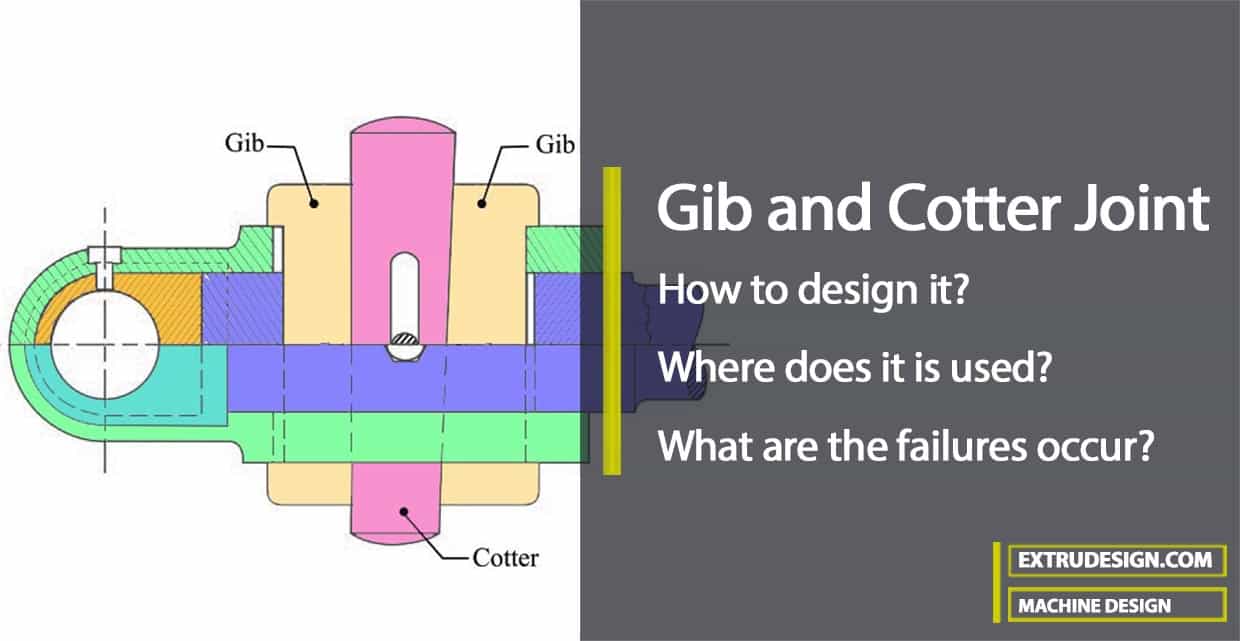
Cotter Joint
A Cotter joint is a joint which is locked by a cotter. A cotter is a flat wedge-shaped piece of rectangular cross-section and its width is tapered from one end to another for an easy adjustment. Mostly it is tapered on one side but sometimes it may be tapered on both sides.
- A Typical Cotter has a taper that varies from 1 in 48 to 1 in 24 and it may be increased up to 1 in 8, if a locking device is provided.
- In order to lock the cotter in place we need additional locking device such as a taper pin or a set screw on the lower end of the cotter to keep in its place.
- The cotter is usually made of mild steel or wrought iron.
- The cotter joint comes under the temporary fastening method.
- Cotter Joints are used to connect rigidly two co-axial rods or bars which are subjected to axial tensile or compressive forces.
- This cotter joints can be fount in well know applications such as in
- Connecting a piston rod to the cross-head of a reciprocating steam engine,
- Connecting a piston rod and its extension as a tail or pump rod,
- in strap end of connecting rod
Gib and Cotter Joint
A gib is a piece of mild steel having the same thickness and taper as the cotter. A gib and cotter joint is usually used in the strap end (or big end) of a connecting rod as shown below figure.
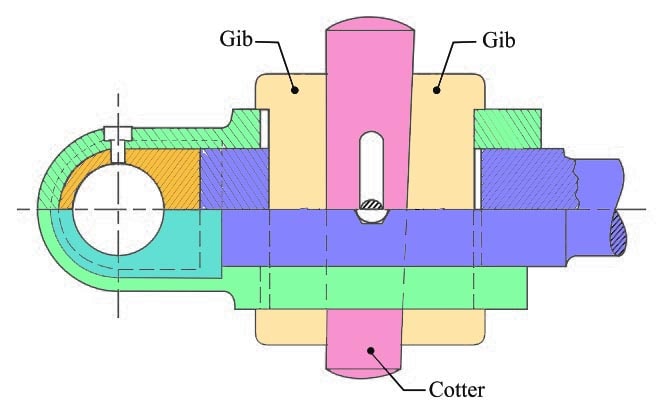
For the cotter joint, we have a possibility that we do not need to use the gib. In such cases, when the cotter alone is used, the friction between its ends and the inside of the slots in the strap tends to cause the sides of the strap to spring open outwards as shown dotted in the below figure.
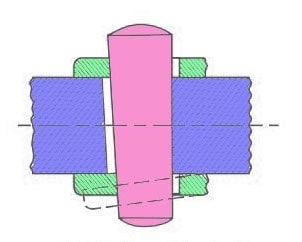
We have to prevent this, so we have to use Gibs. So what if we have used Gib as shown below. Either we can use one Gib or two Gibs on both sides which hold together the ends of the strap.
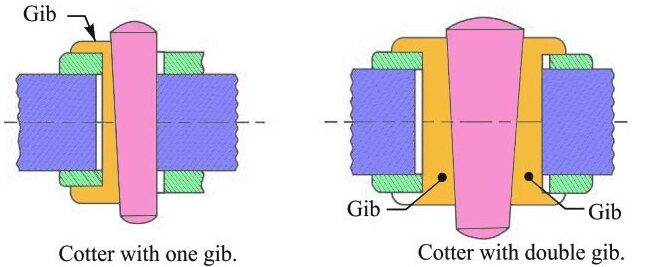
Moreover, gibs provide a larger bearing surface for the cotter to slide on, and it also increases the holding power. Thus, the tendency of cotter to slacken back owing to friction is considerably decreased. The Gib, also, enables parallel holes to be used.
When one gib is used, the cotter with one side tapered is provided and the gib is always on the outside.
When two jibs are used, the cotter with both sides tapered is provided.
Sometimes to prevent loosening of the cotter, a small set screw is used through the rod jamming against the cotter
Design of a Gib and Cotter Joint for Strap End of a Connecting Rod
Let us Consider a Gib and Cotter Joint for the big end of a connecting rod as shown in the below figure. The connecting rod is subjected to tensile and compressive loads.
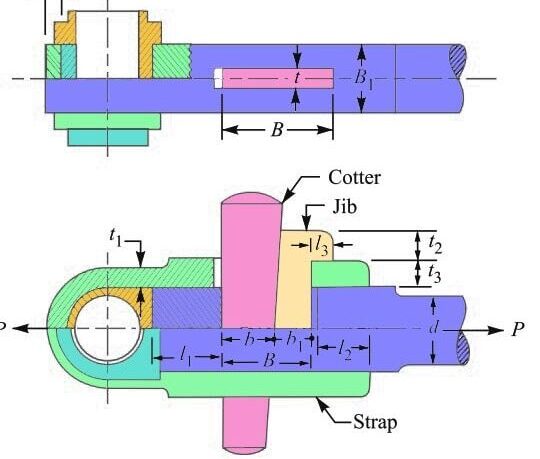
Let us say
P = Maximum thrust or pull in the connecting rod,
d = Diameter of the adjacent end of the round part of the rod,
B1 = Width of the strap,
B = Total width of gib and cotter,
t = Thickness of cotter,
t1 = Thickness of the strap at the thinnest part,
σt = Permissible tensile stress for the material of the strap, and
τ = Permissible shear stress for the material of the cotter and gib.
In general, the width of the strap (B1) is considered to be equal to the diameter of the adjacent end of the round part of the rod (d). The other dimensions will be determined from the relation given below.
The thickness of cotter = Width of the strap/4
t = B1/4
The thickness of gib = Thickness of cotter (t)
The Height of the Gib Head (t2) = Length of gib head (l3) = Thickness of cotter (t)
In order to determine these dimensions for a Gib and cotter joint, we need to consider the possible failures that may occur in the different parts of this joint and the permissible stress for the materials used for this cotter joint. These possible failures are mentioned below.
- Failure of the strap in tension
- Failure of the gib and cotter in shearing
These possible failures of different parts of the Gib and cotter joint are considered to determine the above parameters.
Thickness of the strap (t1)
By considering the Failure of the strap in tension, we can determine the thickness of the strap at its thinnest, and also The thickness of the strap at the cotter (t3) is also determined eventually.
Assuming that no hole is provided for lubrication, the cross-sectional area that resists the failure of the strap due to tearing = 2 B1 × t1
The tearing strength of the strap will be the product of the cross-sectional area that resists the failure of the strap due to tear and tensile stress.
= 2 B1 × t1× σt
Now, let us equate this relation with the load (P), we can write
P = 2 B1 × t1× σt
From this equation, we can determine the thickness of the strap at the thinnest part (t1). This is the case where there is no oil hole is provided in the strap.
If an oil hole is provided in the strap, then its weakening effect should also be considered.
The thickness of the strap at the cotter (t3) is increased such that the area of cross-section of the strap at the cotter hole is not less than the area of the strap at the thinnest part.
2 t3 (B1 – t) = 2 t1 × B1
From this expression, we can determine the value of t3 if there is an oil hole present.
Total Width of the Gib and Cotter (B)
In order to determine the total width of Gib and Cotter, we need to consider the Failure of the gib and cotter under shearing.
Since we considered that the gib and cotter are in double shear, therefore area resisting failure will be
= 2 B × t
and resisting strength will be = 2 B × t × τ
Equating this to the load (P), we can write
P = 2 B × t × τ
From this equation, we can determine the total width of the gib and cotter (B).
We have used one Gib on the Connecting Rob Strap End, the proportions of gib and cotter are to be followed as mentioned below.
The Width of gib (b1) =0.55 B
The width of cotter (b) = 0.45 B
The thickness of the strap at the crown (t4) = 1.15 t1 to 1.5 t1
l1 = 2 t1
l2 = 2.5 t1
These are all the proportions of the dimensions for the Gib and Cotter Joint.
Let us solve a sample problem to design a Gib and Cotter Joint.
Example Problem Statement
The big end of a connecting rod is subjected to a maximum load of 50 kN. The diameter of the circular part of the rod adjacent to the strap end is 75 mm. Design the Cotter joint with a Gib, assuming permissible tensile stress for the material of the strap as 25 MPa and permissible shear stress for the material of cotter and gib as 20 MPa.
Answer:
Given That
Load (P) = 50 kN = 50 × 103 N
Diameter of the circular part of the rod adjacent to the strap (d) = 75 mm
permissible tensile stress (σt)= 25 MPa = 25 N/mm2
permissible shear stress (τ) = 20 MPa = 20 N/mm2
1. Width of the strap
Let us say B1 = Width of the strap.
The width of the strap is generally made equal to the diameter of the adjacent end of the round part of the rod (d).
B1 = d = 75 mm Ans.
Other dimensions are also fixed as mentioned above, those are
The thickness of the cotter (t) = B1/4
t = 75/4
t = 18.75
Let us take the thickness of the Cotter as 20mm.
The thickness of the gib = Thickness of the cotter = 20mm
The Height of the Gib Head (t2) = Length of gib head (l3) = Thickness of cotter (t) = 20 mm
2. Thickness of the strap at the thinnest part
Let us say t1 = Thickness of the strap at the thinnest part.
Considering the failure of the strap in tension. We know that load (P),
P = 2 B1 × t1× σt
50 × 103 = 2 B1 × t1 × σt
50 × 103= 2 × 75 × t1 × 25
50 × 103= 3750 t1
t1 = 50 × 103 / 3750
t1 = 13.3
The thickness of the strap at the thinnest part is 13.3mm, let us take this as 15mm.
3. Thickness of the strap at the cotter
Let us say t3 = Thickness of the strap at the cotter.
The thickness of the strap at the cotter is increased such that the area of the cross-section of the strap at the cotter hole is not less than the area of the strap at the thinnest part. In other words,
2 t3 (B1 – t) = 2 t1 × B1
2 t3 (75 – 20) = 2 × 15 × 75
110 t3= 2250
t3 = 2250 / 110
t3 = 20.45
The thickness of the Strap at the cotter is 20.45mm, let us take this as 21mm.
4. Total width of gib and cotter
Let us say B = Total width of gib and cotter.
Considering the failure of gib and cotter in double shear. We know that load (P),
P = 2 B × t × τ
50 × 103 = 2 B × t × τ
50 × 103= 2 B × 20 × 20
50 × 103= 800 B
B = 50 × 103 / 800
B = 62.5
We got the Total width of the gib and cotter as 62.5mm, let us take this value as 65mm.
We have the following proportions for the remaining parameters of the Gib and Cotter Joint those are
The Width of gib (b1) = 0.55 B = 0.55 × 65 = 35.75 let us take this value as 36mm
The width of cotter (b) = 0.45 B = 0.45 × 65 = 29.25 let us take this value as 30mm
The thickness of the strap at the crown (t4) = 1.25 t1 = 1.25 × 15 = 18.75 let us take this value as 20mm
l1 = 2 t1 = 2 × 15 = 30mm
l2 = 2.5 t1 = 2.5 × 15 = 37.5 let us take this value as 40mm.
These are all parameters of the Gib and Cotter Joint.
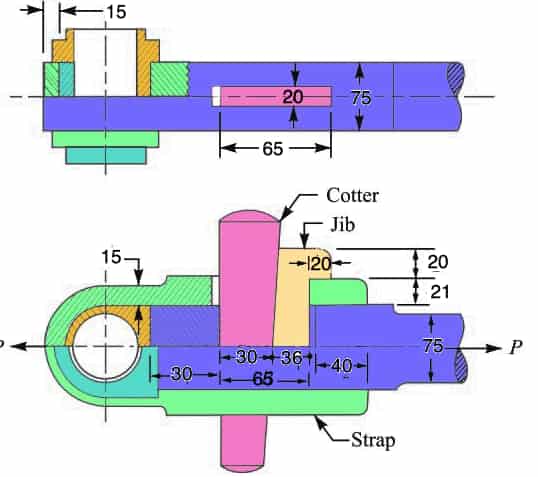
Applications of Cotter Joints
- Historically, the Cottar joint has been used to connect connecting rods to steam engines and pumps used in dumping mines.
- Cotter Joints are used between the piston rod and the tail of the pump rod.
- Cotter’s joints are used between the slide spindle and the fork of the valve mechanism.
- Cotter and Dowell arrange to join two parts of a flywheel.
- Foundation bolt: mainly used for fastening foundation and construction heavy machines
- In an automobile engine, the cotter joint is used to connect the extension of the piston rod with the connecting rod in the crosshead.
- The Cottar joint has historically been used to connect connecting rods to steam engines and pumps of dumping mines.
- It is used in bicycles to connect the paddle to the sprocket wheel.
- Use a wet air pump to join a tail rod with the piston rod.
- It is used to connects two rods of equal diameter subjected to axial forces.

Leave a Reply